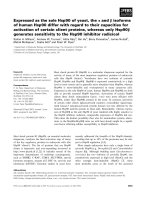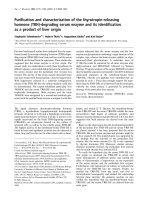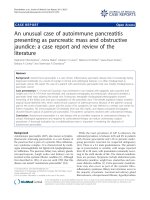Supermoney as profound and witty as the money game
Bạn đang xem bản rút gọn của tài liệu. Xem và tải ngay bản đầy đủ của tài liệu tại đây (2.89 MB, 341 trang )
FOR SALE & EXCHANGE
www.trading-software-collection.com
Subscribe for FREE download more stuff.
Mirrors:
www.forex-warez.com
www.traders-software.com
Contacts
Skype: andreybbrv
ICQ: 70966433
SUPERMONEY
INTRODUCING
WILEY INVESTMENT CLASSICS
There are certain books that have redefined the way we
see the worlds of finance and investing—books that
deserve a place on every investor’s shelf. Wiley Investment
Classics will introduce you to these memorable books,
which are just as relevant and vital today as when they
were first published. Open a Wiley Investment Classic and
rediscover the proven strategies, market philosophies, and
definitive techniques that continue to stand the test of
time.
SUPERMONEY
‘ADAM
SMITH’
JOHN WILEY & SONS, INC.
Copyright © 1972 by ‘Adam Smith’. All rights reserved
Foreword copyright © 2006 by John Wiley & Sons, Inc. All rights reserved
Preface copyright © 2006 by ‘Adam Smith’. All rights reserved
Published by John Wiley & Sons, Inc., Hoboken, New Jersey
Published simultaneously in Canada
Originally published in 1972 by Random House.
No part of this publication may be reproduced, stored in a retrieval system, or
transmitted in any form or by any means, electronic, mechanical,
photocopying, recording, scanning, or otherwise, except as permitted under
Section 107 or 108 of the 1976 United States Copyright Act, without either
the prior written permission of the Publisher, or authorization through
payment of the appropriate per-copy fee to the Copyright Clearance Center,
Inc., 222 Rosewood Drive, Danvers, MA 01923, (978) 750-8400, fax (978) 7504470, or on the web at www.copyright.com. Requests to the Publisher for
permission should be addressed to the Permissions Department, John Wiley
& Sons, Inc., 111 River Street, Hoboken, NJ 07030, (201) 748-6011, fax (201)
748-6008, or online at />Limit of Liability/Disclaimer of Warranty: While the publisher and author
have used their best efforts in preparing this book, they make no
representations or warranties with respect to the accuracy or completeness of
the contents of this book and specifically disclaim any implied warranties of
merchantability or fitness for a particular purpose. No warranty may be
created or extended by sales representatives or written sales materials. The
advice and strategies contained herein may not be suitable for your situation.
You should consult with a professional where appropriate. Neither the
publisher nor author shall be liable for any loss of profit or any other
commercial damages, including but not limited to special, incidental,
consequential, or other damages.
For general information on our other products and services or for technical
support, please contact our Customer Care Department within the United
States at (800) 762-2974, outside the United States at (317) 572-3993 or fax
(317) 572-4002.
Wiley also publishes its books in a variety of electronic formats. Some content
that appears in print may not be available in electronic books. For more
information about Wiley products, visit our web site at www.wiley.com.
ISBN-13 978-0-471-78631-3
ISBN-10 0-471-78631-4
Printed in the United States of America
10 9 8 7 6 5 4 3 2 1
For Mark O. Park
and
Susannah B. Fish
CONTENTS
Foreword
Preface
I. SUPERMONEY
1. Metaphysical Doubts, Very Short
2. Liquidity: Mr. Odd-Lot Robert Is Asked How
He Feels
3. Supermoney, Where It Is: The Supercurrency
I I . T H E D AY T H E M U S I C
ALMOST DIED
ix
xxvii
1
3
4
15
29
1. The Banks
June 1970
2. The Brokers
September 1970
50
III. THE PROS
67
1. Nostalgia Time: The Great Buying Panic
2. An Unsuccessful Group Therapy Session for
Fifteen Hundred Investment Professionals
Starring the Avenging Angel
31
69
78
vii
CONTENTS
3. Cautionary Tales
Remember These, O Brother, in Your New
Hours of Triumph
95
4. How My Swiss Bank Blew $40 Million and
Went Broke
110
5. Somebody Must Have Done Something Right:
The Lessons of the Master
171
I V. I S T H E S Y S T E M B L O W N ?
1. The Debased Language of Supercurrency
2. Co-opting Some of the Supercurrency
3. Beta, Or Speak to Me Softly in Algebra
Well, Watchman, What of the Night? Arthur
Burns’s angst; Thirteen Ways of Looking at a
Blackbird; Prince Valiant and the Protestant
Ethic; Work and Its Discontents; Will General
Motors Believe in Harmony? Will General
Electric Believe in Beauty and Truth? Of the
Greening and Blueing, and Cotton Mather
and Vince Lombardi and the Growth of
Magic; and What Is to Be Done on Monday
Morning.
SOME NOTES
Table I: Sector Statements of Saving and
Investment: Households, Personal Trusts,
and Nonprofit Organizations
II. Table II: Funds Raised, Nonfinancial Sectors
III. Table III: The Runoff in Commercial Paper;
Summer 1970
IV. Portfolio of the University of Rochester
199
201
215
223
235
287
I.
viii
291
293
294
295
FOREWORD
Supermoney, along with its predecessor, The Money
Game, told the story of what came to be known as the “GoGo” years in the U.S. stock market. It is the book that
introduced Warren Buffett, now the world’s most noted
investor, long before he became the paradigm of investment success and homespun financial wisdom. In Supermoney, author “Adam Smith” travels to Omaha to meet
this Will Rogers character, and later brings him on his television show, Adam Smith’s Money World. Buffett’s distinction in the Go-Go era was that he was one of the few who
divined it correctly, quietly dropping out and closing the
investment fund he managed. His remaining interest, in a
thinly traded New England textile company, Berkshire
Hathaway, would later become the vehicle for what may
well be the most successful investment program of all time.
The era of speculation described in The Money Game—
and in Supermoney—began in the early 1960s and was
pretty much over by 1968, only to be succeeded by yet
ix
FOREWORD
another wave of speculation—albeit one that was starkly
different in its derivation—that drove the stock market
ever higher through early 1973.Then the bubble of that era
burst. By the autumn of 1974 the market had fallen by 50
percent from its high, taking it back below the level it
reached in 1959, 15 years earlier.
Both books reached large, eager, and well-informed
audiences, deservedly earning best-seller status. In them,
the author “Adam Smith” recounted perceptive, bouncing,
often hilarious anecdotes about the dramatis personae of
the stage show that investing had become. While The
Money Game was essentially a study in the behavior of
individual investors, Supermoney, as its book jacket
reminded us, was about the social behavior of institutional
investors, focusing on the use of “supercurrency”—income
garnered through market appreciation and stock options—
that became the coin of the realm during the Go-Go years.
These two books quickly became part of the lore of
investing in that wild and crazy era. In retrospect, however,
they provided Cassandra-like warnings about the next wild
and crazy era, which would come, as it happens, some three
decades later. The New Economy bubble of the late 1990s,
followed by, yes, another 50 percent collapse in stock prices,
had truly remarkable parallels with its earlier counterpart.
Surely Santayana was right when he warned that “those
who cannot remember the past are condemned to repeat it.”
In the aftermath of that second great crash, as investors
again struggle to find their bearings, the timing of this new
edition of Supermoney is inspired. It is a thoroughly
enchanting history, laced with wit and wisdom that provides useful lessons for those investors who didn’t live
through the Go-Go years. It also provides poignant reminiscences for those who did live through them. Using the
insightful (but probably apocryphal) words attributed to
Yogi Berra, it is “déjà vu all over again.”
x
FOREWORD
I consider myself fortunate to have learned the lessons
of the Supermoney bubble, albeit the hard way. While I was
among those who lived and lost, both personally and professionally, in that era, I summoned the strength to return
and fight again. Hardened in the crucible of that experience, I reshaped my ideas about sound investing. So as the
New Economy bubble inflated to the bursting point in the
years before the recent turn of the century, I was one of a
handful of Cassandras, urging investors to avoid concentration in the high-tech stocks of the day, to diversify to the nth
degree, and to allocate significant assets to, yes, bonds.
I also consider myself fortunate to have known and
worked with Jerry Goodman (the present-day Adam
Smith) during this long span, having been periodically
interviewed for Institutional Investor magazine (of which
he was founding editor) and for his popular Public Broadcasting Network television show, Adam Smith’s Money
World. We served together on the Advisory Council of the
Economics Department of Princeton University during
the 1970s, where his strong and well-founded opinions
were a highlight of our annual roundtable discussions.
While I have no hesitation in acknowledging Jerry’s superior mind and writing skill—a nice combination!—I console myself with our parity on the fields of combat. (Exact
parity: Years ago, on a Princeton squash court, we were
tied at 2–2 in the match and at 7–7 in the deciding game
when the lights went out and the match ended.)
As one of a very few participants who has been part of
the march of the financial markets during a period that has
now reached 55 years—including both the Go-Go bubble
of yore and the New Economy bubble of recent memory—
I’m honored and delighted to contribute the foreword to
this 2006 reissue of a remarkable book. I’ll first discuss the
excesses of the Supermoney era; next, the relentless retribution that came in its aftermath; and finally, the coming
xi
FOREWORD
and going of yet the most recent example of the “extraordinarily popular delusions and the madness of crowds”
that have punctuated the financial markets all through history. Of course, if tomorrow’s investors actually learn from
the hard-won experience of their elders and the lessons of
history chronicled in this wonderful volume, there will
never be another bubble. But I wouldn’t count on it!
Part One: The Supermoney Era
The Goodman books chronicled an era that verged on—
and sometimes even crossed the line into—financial insanity: the triumph of perception over reality, of the transitory
illusion of earnings (to say nothing of earnings calculations
and earnings expectations) over the ultimate fundamentals of balance sheets and discounted cash flows. It was an
era in which investors considered “concepts” and “trends”
as the touchstones of investing, easily able to rationalize
them, since they were backed by numbers, however dubious their provenance. As Goodman writes in his introduction to this new edition: “. . . people viewed financial
matters as rational, because the game was measured in
numbers, and numbers are finite and definitive.”
During the Money Game/Supermoney era, perception
was able to overwhelm reality in large measure because of
financial trickery that made reality appear much better
than it was. “Adam Smith” described how easy it was to
inflate corporate earnings:“Decrease depreciation charges
by changing from accelerated to straight line . . . change
the valuation of your inventories . . . adjust the charges
made for your pension fund . . . capitalize research instead
of expensing it . . . defer the costs of a project until it brings
in revenues . . . play with pooling and purchase (accounting) . . . all done with an eye on the stock, not on what
xii
FOREWORD
might be considered economic reality.” And the public
accountants, sitting by in silence, let the game go on. The
most respected accountant of the generation, Leonard
Spacek, chairman emeritus of Arthur Andersen, was
almost alone in speaking out against the financial engineering that had become commonplace: “How my profession can tolerate such fiction and look the public in the eye
is beyond my understanding . . . financial statements are a
roulette wheel.” His warning was not heeded.
The acceptance of this foolishness by the investment
community was broad and deep. Writing in Institutional
Investor in January 1968, no less an industry guru than
Charles D. Ellis, then an analyst at institutional research
broker Donaldson, Lufkin and Jenrette, concluded that
“short-term investing may actually be safer than long-term
investing sometimes, and the price action of the stocks may
be more important than the ‘fundamentals’ on which most
research is based . . . portfolio managers buy stocks, they
do not ‘invest’ in corporations.”
Yet reality, finally, took over. When it did, the stocks that
were in the forefront of the bubble collapsed, fallen idols
that proved to have feet of clay. Consider this table from
Supermoney:
National Student Marketing
Four Seasons Nursing Homes
Parvin Dohrmann
Commonwealth United
Susquehanna
Management Assistance
Subsequent
High
Low
36
11/2
91
0
142
14
25
1
80
7
46
2
Stocks like these were among the favorites of mutual
fund managers, and those that played the money game
the hardest had the greatest near-term success. In its 1966
xiii
FOREWORD
edition, the Investment Companies manual, published annually by Arthur Wiesenberger & Co. since the early 1940s,
even created a special category for such funds. “Maximum
Capital Gain” (MCG) funds were separated from the traditional “Long-Term Growth, Income Secondary” (LTG)
funds, with remaining equity funds in the staid “Growth
and Current Income” (GCI) funds category. During the
Go-Go era (1963–1968 inclusive), the disparities in returns
were stunning: GCI funds, +116 percent; LTG funds, +151
percent; MCG funds, a remarkable +285 percent.
At the beginning of the Go-Go era, there were 22 MCG
funds; at the peak, 143. Amazingly, after its initial offering
in 1966, Gerald Tsai’s Manhattan Fund—a hot IPO in an
industry that had never before had even a warm IPO—was
placed in the LTG category. The offering attracted $250
million, nearly 15 percent of the total cash flow into equity
funds for the year, and its assets would soar to $560 million
within two years. Tsai was the inscrutable manager who
had turned in a remarkable record in running Fidelity Capital Fund—+296 percent in 1958–1965 compared to a gain
of 166 percent for the average conservative equity fund.
An article in Newsweek epitomized Tsai’s lionization:
“radiates total cool . . . dazzling rewards . . . no man wields
greater influence . . . king of the mutual funds.” Tsai, no
mean marketer, described himself as “really very conservative,” and even denied that there was “such a thing as a
go-go [fund].”
During the bubble of 1963–1968, equally remarkable
gains were achieved by other Go-Go funds. With the S&P
500 up some 99 percent, Fidelity Trend Fund rose 245 percent, Winfield Fund leaped 285 percent, and Enterprise
Fund a remarkable 643 percent. But after the 1968 peak,
these funds earned unexceptional—indeed subpar—
returns during the period from 1969 to 1971. Nonetheless,
with their extraordinary performance during the boom
xiv
FOREWORD
years (however achieved), their lifetime records through
1971 continued to appear extraordinary.
It was not only mutual funds that joined in the market
madness. While the cupidity of fund managers could at least
be understood, it was not obvious why major not-for-profit
institutions also succumbed. Even the Ford Foundation
added fuel to the fire, warning that, “over the long run, caution has cost our universities more than imprudence or
excessive risk-taking.” The poster child for imprudence was
the University of Rochester’s endowment fund. Supermoney
describes its approach:“to buy the so-called great companies
and not sell them,” a portfolio dominated by holdings in
IBM, Xerox, and Eastman Kodak.The unit value of its portfolio (presented as an appendix in Supermoney) soared from
$2.26 in 1962 to $4.95 in 1967, and to $5.60 in 1971—an aggregate gain of 150 percent. Could it really be that easy?
Alas, if only I knew then what I know now. Lured by the
siren song of the Go-Go years, I too mindlessly jumped on
the bandwagon. In 1965, I was directed by Wellington
Management Company chairman and founder Walter L.
Morgan to “do whatever is necessary” to bring the firm
that I had joined in 1951, right out of college, into the new
era. I quickly engineered a merger with Boston money
manager Thorndike, Doran, Paine, and Lewis, whose Ivest
Fund was one of the top-performing Go-Go funds of the
era. The merger was completed in 1966. In 1967 I callowly
announced to our staff, “We’re #1”—for during the five
years ended December 31, 1966, the fund had delivered
the highest total return of any mutual fund in the entire
industry. So far, so good.
The story of that merger was chronicled in the lead article in the January 1968 issue of Institutional Investor,
whose editor was none other than George J.W. Goodman.
“The Whiz Kids Take Over at Wellington” described how
the new partners had moved Wellington off the traditional
xv
FOREWORD
“balanced” investment course to a new “contemporary”
course. In Wellington Fund’s 1967 annual report, it was
described as “dynamic conservatism” by the fund’s new
portfolio manager, Walter M. Cabot:
Times change. We decided we too should change to bring the
portfolio more into line with modern concepts and opportunities.
We have chosen “dynamic conservatism” as our philosophy, with
emphasis on companies that demonstrate the ability to meet,
shape and profit from change. [We have] increased our common
stock position from 64 percent of resources to 72 percent, with a
definite emphasis on growth stocks and a reduction in traditional
basic industries. A conservative investment fund is one that
aggressively seeks rewards, and therefore has a substantial exposure to capital growth, potential profits and rising dividends . . .
[one that] demands imagination, creativity, and flexibility.We will
be invested in many of the great growth companies of our society.
Dynamic and conservative investing is not, then, a contradiction
in terms. A strong offense is the best defense.
When one of the most conservative funds in the entire
mutual fund industry begins to “aggressively seek
rewards,” it should have been obvious that the Go-Go era
was over.And it was over. Sadly, in the market carnage that
would soon follow, the fund’s strong offense, however
unsurprisingly, turned out to be the worst defense.
Part Two: Retribution Comes
When there is a gap between perception and reality, it is
only a matter of time until the gap is reconciled. But since
reality is so stubborn and tolerates no gamesmanship, it is
impossible for reality to rise to meet perception. So it follows that perception must decline to meet reality. Après
moi le déluge.
xvi
FOR SALE & EXCHANGE
www.trading-software-collection.com
Subscribe for FREE download more stuff.
Mirrors:
www.forex-warez.com
www.traders-software.com
Contacts
Skype: andreybbrv
ICQ: 70966433
FOREWORD
The ending of the Go-Go era in 1968 was followed by a
5 percent decline in the stock market during 1969 and 1970.
Even larger losses (averaging 30 percent) were incurred by
the new breed of aggressive investors. But that decline was
quickly offset by a 14 percent market recovery in 1971 (just
as Jerry Goodman was writing Supermoney). In 1972, with
another 19 percent gain, the market’s snapback continued.
For the two years combined, the market and the MCG
funds produced a total return of about 35 percent.
Those final two years of the bubble reflected a subtle
shift from the Go-Go era to the “Favorite Fifty” era. But
that metamorphosis didn’t help the other, more conservative, equity funds. Why? Because as the bubble mutated
from generally smaller concept stocks to large, established
companies—“the great companies” epitomized in the
Rochester portfolio, sometimes called the “Favorite Fifty,”
sometimes the “Vestal Virgins”—the stock prices of these
companies, too, lost touch with the underlying economic
reality, trading at price-earnings multiples that, as it was
said, “discounted not only the future, but the hereafter.”
But as 1973 began, the game ended. During the next two
calendar years, the aggressive funds tumbled by almost 50
percent on average, with Fidelity Trend off 47 percent and
Enterprise Fund off 44 percent. (Winfield Fund, off 50 percent in 1969–1970, was no longer around for the final carnage.) Tsai’s Manhattan Fund, remarkably, did even worse,
tumbling by 55 percent. By December 31, 1974, Manhattan
Fund had provided the worst—the worst—eight-year record
in the entire mutual fund industry: a cumulative loss of 70
percent of its shareholders’ capital. In the meantime, Tsai,
the failed investor but still the brilliant entrepreneur, had
sold his company to CNA Insurance in 1968. By 1974, Manhattan Fund’s assets had dwindled by a mere 90 percent, to
$54 million, becoming a shell of its former self and a name
that virtually vanished into the dustbin of market history.
xvii
FOREWORD
And at Rochester University, the value of the endowment fund—for all the noble intentions of its managers—
also plummeted. The coming of the Go-Go bubble
followed by the Favorite Fifty bubble had carried its unit
value from $3.17 in 1964 to $7.20 in 1972, but their going
had carried it right back to $3.13 in 1974—even below
where it had begun a decade earlier. Après moi le déluge
indeed! (Reflecting the embarrassment of the Rochester
managers, the cover of the endowment fund’s annual report
for 1974 was red, “the deepest shade we could find.”)
My face was red, too. I can hardly find words to describe
first my regret and then my anger at myself for having
made so many bad choices. Associating myself—and the
firm with whose leadership I had been entrusted—with a
group of go-go managers. The stupid belief that outsized
rewards could be achieved without assuming outsized
risks. The naive conviction that I was smart enough to defy
the clear lessons of history and select money managers
who could consistently provide superior returns. Putting on
an ill-fitting marketing hat to expand Wellington’s “product line” (a phrase I have come to detest when applied to
the field of money management, accurate today only
because the fund field is now one of money marketing, and,
ugh!, product development). I, too, had become one of the
mad crowd that harbored the extraordinary popular delusions of the day.
Ultimately, alas, the merger that I had sought and accomplished not only failed to solve Wellington’s problems, it
exacerbated them. Despite the early glitter of success for
the firm during the Go-Go years, the substance proved illusory. As a business matter, the merger worked beautifully
for the first five years, but both I and the aggressive investment managers whom I had too opportunistically sought as
my new partners let our fund shareholders down badly. In
the great bear market of 1973–1974, stock prices declined
xviii
FOREWORD
by a devastating 50 percent from high to low. Even for the
full two-year period, the S&P 500 Index provided a total
return (including dividends) of minus 37 percent.
Most of our equity funds did even worse. During the
same period, for example, Ivest lost a shocking 55 percent
of its value. In my annual chairman’s letter to shareholders
for 1974, I bluntly reported that “the fund’s net asset value
declined by 44 percent for the August 31 fiscal year. . . .
Comparing this with a decline of 31 percent for the S&P
500 . . . we regard the fund’s performance as unsatisfactory.” (One of the fund’s directors was appalled by my
recognition of this seemingly self-evident fact. He soon
resigned from the board.) We had also started other aggressive funds during this ebullient era. When the day of reckoning came, they, too, plummeted far more than the S&P
500: Explorer, –52 percent; Morgan Growth Fund, –47 percent; and Trustees’ (!) Equity Fund, –47 percent. The latter
fund folded in 1978, and a speculative fund—Technivest—
that we designed to “take advantage of technical market
analysis” (I’m not kidding!) folded even earlier.
Even our crown jewel, Wellington Fund, with that earlier increase in its equity ratio and a portfolio laden with
“the great growth companies of our society,” suffered a 26
percent loss in 1973–1974. Its record since the 1966 merger
was near the bottom of the balanced fund barrel. With the
average balanced fund up 23 percent for the decade,
Wellington’s cumulative total return for the entire period
(including dividends) was close to zero—a mere 2 percent.
(In 1975, portfolio manager Cabot left the firm to become
manager of the Harvard Endowment Fund.)
In a business environment that was falling apart almost
week by week, this terrible performance put enormous
strains on the once-cooperative partnership, strains that
were soon exacerbated by personal differences, conflicting
ambitions and egos, and the desire to hold the reins of
xix
FOREWORD
power. Not surprisingly, my new partners and I had a
falling-out. But they had more votes on the board, and it
was they who fired me from what I had considered “my”
company.
I had failed our shareholders and I had failed in my
career—not in getting fired, but in jumping on the speculative bandwagon of aggressive investing in the first place.
Life was fair, however: I had made a big error and I paid a
high price.* I was heartbroken, my career in shambles. But
I wasn’t defeated. I had always been told that when a door
closed (this one had slammed!), a window would open. I
decided that I would open that window myself, resume my
career, and change the very structure under which mutual
funds operated, which was, importantly, responsible for the
industry’s abject failure during the Go-Go era. I would
make the mutual fund industry a better place to invest.
But how could that goal be accomplished? With the
essence of simplicity. Why should mutual funds retain an
outside company to manage their affairs—then, and now,
the modus operandi of our industry—when, once they
reach a critical asset mass, funds are perfectly capable of
managing themselves and saving a small fortune in fees?
Why not create a structure in which mutual funds would,
uniquely, be truly mutual? They would be run, not in the
interest of an external adviser—a business whose goal is to
earn the highest possible profit for its own separate set of
owners—but in the interest of their own shareholder/owners, at the lowest possible cost. The firm would not be run
*
Ironically, the original partners who fired me—those who were directly
responsible for the performance problems—paid no price at all. They
took full control of Wellington Management and earned enormous
rewards in the great bull market that would begin in 1982. Nonetheless,
they too apparently learned from their experience in the crash and ultimately restored Wellington to its earlier incarnation as a sound,
respected, and conservative money manager.
xx
FOREWORD
on the basis of product marketing. The funds would focus,
not on hot sectors of the market, but on the total market
itself. The core investment philosophy would eschew the
fallacy of short-term speculation and trumpet the wisdom
of long-term investing. And so, on September 24, 1974, out
of all the hyperbole and madness of the Go-Go era and the
Favorite Fifty era, and the travail of the great crash that
followed, came the creation of the Vanguard Group of
Investment Companies.
Part Three: Another Bubble
One of the most engaging anecdotes in Supermoney is the
tale of an annual investment conference in New York City
that attracted some 1,500 trust officers and mutual fund
managers (presumably the 1970 Conference held by Institutional Investor magazine). Jerry Goodman was the moderator, and as he writes, he “thought it would be a nice
psychological purge after the (then) worst year of the Big
Bear, if some of the previous winners could get up and confess their big sins.” However good for the soul that might
have been, few confessions were forthcoming. But the
crowd was reminded of its sins by crusty New Englander
David Babson, who described the stock market of the day
as “a national craps game.” His philosophy as an investment manager revolved around hard work and common
sense, “virtues that would triumph in the long run.”
He lashed into the assembled crowd, describing how professional investors had “gotten sucked into speculation,”
reading off a list, name by name, of once-vaunted stocks that
had plummeted in price (from 80 to 7, 68 to 4, 46 to 2, 68 to
3, and so on), and suggesting that some of the assembled
managers should leave the business. Despite Goodman’s
warning (“David, you have passed the pain threshold of the
xxi
FOREWORD
audience”), Babson singled out “the new breed of investment managers who bought and churned the worst collection of new issues and other junk in history, and the
underwriters who made a fortune in bringing them out . . .
and elements of the financial press which promoted into
new investment geniuses a group of neophytes who had . . .
no sense of responsibility for managing other people’s
money.” Babson concluded that “no greater period of skullduggery in American financial history exists than 1967 to
1969. It has burned this generation like 1929 did another
one, and it will be a long, long time before it happens again.”
As one might imagine, Mr. Babson’s remarks were not
well received by the audience of money managers. But
while he failed to foresee a second leg of the bubble (the
Favorite Fifty era) that would quickly follow, he was right.
Just as some 35 years had elapsed from 1929 until the start
of the Go-Go era in 1965, so some 33 years would elapse
before the next bubble emerged. Once again, a new generation would forget the lessons learned by its predecessors.
Some of the causes of the new bubble were the same.
(They may be eternal.) David Babson had listed them:
“Accountants who played footsie with stock-promoting
managements by classifying earnings that weren’t earnings
at all.‘Modern’ corporate treasurers who looked upon their
company pension funds as new-found profit centers . . .
mutual fund managers who tried to become millionaires
overnight by using every gimmick imaginable to manufacture their own paper performance . . . security analysts who
forgot about their professional ethics to become storytellers and let their institutions be taken in by a whole
parade of confidence men.” Charles Ellis’s 1968 insight that
“portfolio managers buy stocks, they do not ‘invest’ in corporations” also came back to haunt us. (With a twist, of
course. Managers didn’t merely buy stocks; they traded
them with unprecedented ferocity.)
xxii









